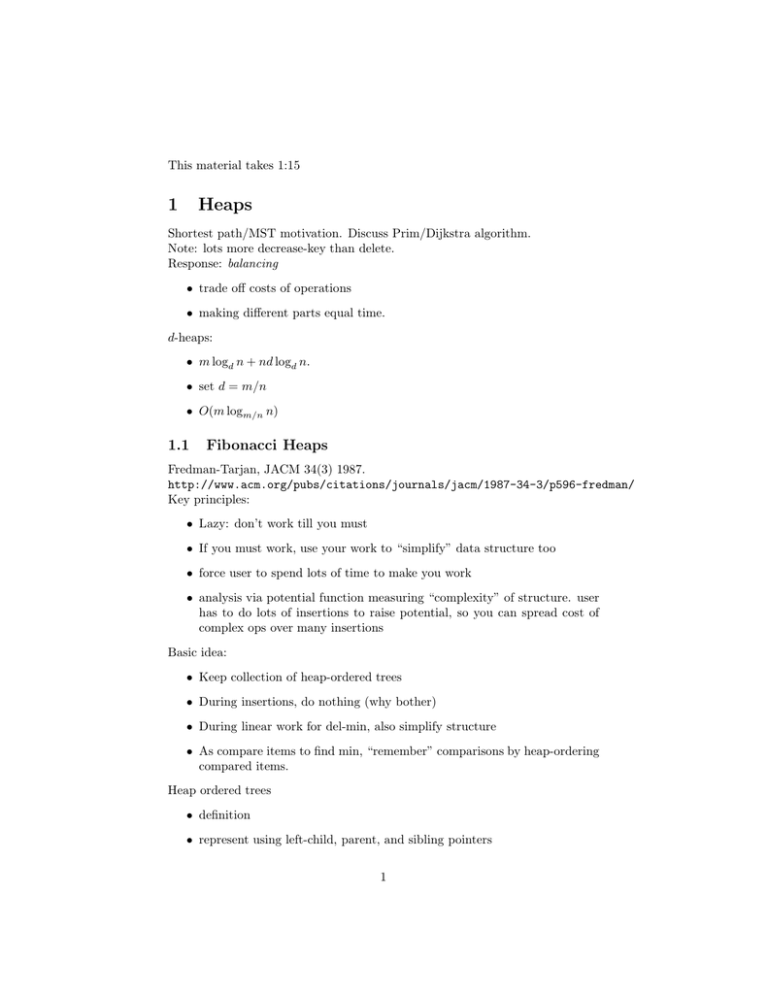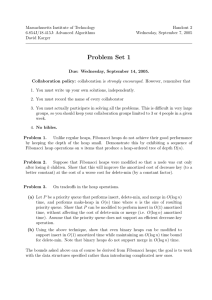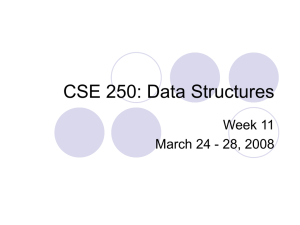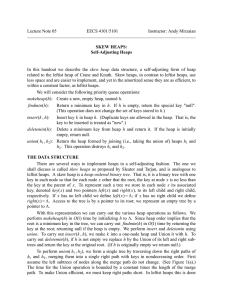Document 13546579
advertisement

This material takes 1:15
1
Heaps
Shortest path/MST motivation. Discuss Prim/Dijkstra algorithm.
Note: lots more decrease-key than delete.
Response: balancing
• trade off costs of operations
• making different parts equal time.
d-heaps:
• m logd n + nd logd n.
• set d = m/n
• O(m logm/n n)
1.1
Fibonacci Heaps
Fredman-Tarjan, JACM 34(3) 1987.
http://www.acm.org/pubs/citations/journals/jacm/1987-34-3/p596-fredman/
Key principles:
• Lazy: don’t work till you must
• If you must work, use your work to “simplify” data structure too
• force user to spend lots of time to make you work
• analysis via potential function measuring “complexity” of structure. user
has to do lots of insertions to raise potential, so you can spread cost of
complex ops over many insertions
Basic idea:
• Keep collection of heap-ordered trees
• During insertions, do nothing (why bother)
• During linear work for del-min, also simplify structure
• As compare items to find min, “remember” comparisons by heap-ordering
compared items.
Heap ordered trees
• definition
• represent using left-child, parent, and sibling pointers
1
• in contant time, can link two of them (Fibonacci heaps are mergeable in
constant time)
• in constant time, can add item
• in constant time, can decrease key (split key off, then merge)
• time to delete-min equal number of children and roots.
Goal: use heap-ordered trees, but keep degree small!
• method: ensure that any node has descendant count exponential in degree.
• how?
– keep a bunch of separate heap-trees
– only link heaps of same degree
• lemma: if only link heaps of same degree, than any degree-d heap has 2d
nodes.
• creates “binomial trees” (draw)
• “Binomial heaps” do this aggressively—when delete items, split up trees
to preserve exact tree shapes.
Algorithm:
• Maintain list of heap ordered trees.
• insert: add to list, update min if necessary
• delete-min:
– remove smallest root
– add its children to list of roots
– scan all roots to find next min
– consolidate treelist by merging pairs of same-degree trees
– (note, since scanning anyway, consolidation is free)
Idea: adversary has to do many insertions to make consolidation expensive.
• analysis: potential function φ equal to number of roots.
– amortizedi = reali + φi − φi−1
�
�
– then
ai = ri + φn − φ0
– upper bounds real cost if φn ≥ φ0 .
• insertion real cost 1, potential cost 1. total 2.
2
• deletion: of r roots at start, log n roots at end. difference pays for scanning
and consolidating all but log n roots, so amortized cost O(log n).
Result: constant insert, O(log n) amortized delete
What about decrease-key?
• bascially easy: cut off node from parent, make root.
• problem: may violate exponential-in-degree property
• fix: if a node loses more than one child, cut it from parent, make it a root
(adds 1 to root potential—ok).
• implement using “mark bit” in node if has lost 1 child (clear when becomes
root)
• may cause “cascading cut” until reach unmarked node
• why 2 children? We’ll see.
Analysis: must show
• cascading cuts “free”
• tree size is exponential in degree
Second potential function: number of mark bits.
• if cascading cut hits r nodes, clears r mark bits
• adds 1 mark bit where stops
• amortized cost: O(1)
• note: if cut without marking, couldn’t pay for cascade!
– this is binomial heaps approach. may do same O(log n) consolidation
and cutting over and over.
Analysis of tree size:
• node x. consider current children in order were added.
• claim: ith remaining child (in addition order) has degree at least i − 2
• proof:
– Let y be ith added child
– When added, the i−1 items preceding it in the add-order were already
there
– i.e., x had degree ≥ i − 1
– So ith child y had (same) degree ≥ i − 1
3
– y could lose only 1 child before getting cut
• let Sk be minimum number of descendants (inc self) of degree k node.
Deduce S0 = 1, S1 = 2, and
Sk ≥
k
−2
�
Si
i=0
• deduce Sk ≥ Fk+2 fibonacci numbers
• reason for name
• we know Fk ≥ φk
Practical?
• Constants not that bad
• ie fib heaps reduces comparisons on moderate sized problems
• but, regular heaps are in an array
• fib heaps use lots of pointer manipulations
• lose locality of reference, mess up cache.
• non-amortized versions with same bounds exist.
1.2
Minimum Spanning Tree
minimum spanning tree (and shortest path) easy in O(m + n log n).
More sophisticated MST:
• why n log n? Because deleting from size-n heap
• idea: keep heap small to reduce cost.
– choose a parameter k
– run prim till region has k neighbors
– set aside and start over elsewhere.
– heap size bounded by k, delete by log k
– “contract” regions (a la Kruskal) and start over.
Formal:
• phase starts with t vertices.
• set k = 22m/t .
• unmark all vertices and repeat following
4
– choose unmarked vertex
– Prim until attach to marked vertex or heap reaches size k
– mark all vertices in region
• contract graph in O(m) time and repeat
Analysis:
• time for phase: m decrease keys, t delete-mins from size-k heaps, so O(m+
t log k) = O(m).
• number of phases:
– At end of phase, each compressed vertex “owns” k edges (one or both
endpoints)
– so next number of vertices t ≤ 2m/k
�
– so k = 22m/t ≥ 2k
– when reach k = n, done (last pass)
– number of phases: β(m, n) = min{i | log(i) n ≤ 2m/n} ≤ log∗ n.
Remarks:
• subsequently improved to O(m log β(m, n)) using edge packets
• chazelle recently improved to O(mα(n) log α(n))
• ramachandran gave optimal algorithm (runtime not clear)
• randomization gives linear.
5







